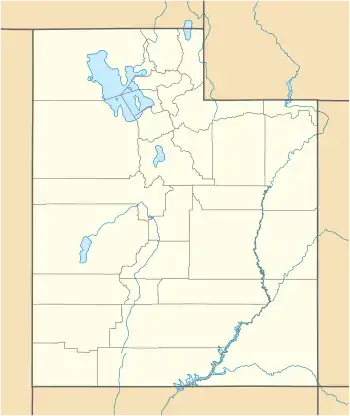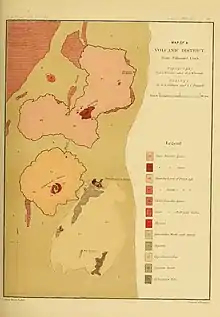The Cinders
The Cinders is a lava field including a volcanic hill named Ice Springs craters in the west-central portion of Utah, United States.[1] It is also known as the Ice Springs Volcanic Field.
| The Cinders | |
|---|---|
 1981 air photo. Image is about 10.5 km wide. | |
| Highest point | |
| Elevation | 4,940 ft (1,510 m) |
| Geography | |
 | |
| Country | United States |
| State | Utah |
| Region | Black Rock Desert volcanic field |
| District | Millard County |
| Range coordinates | 38°54′36″N 112°31′56″W |
| Topo map | USGS Tabernacle Hill, UT |

The Cinders in 2020
Geology

Sample of the basalt of Ice Springs craters

Gilbert and Russell's 1890 Map of the Volcanic District
The Cinders are part of the Black Rock Desert volcanic field. The lava of The Cinders is basalt of late Holocene age. The basalt erupted from the vent at the Ice Springs craters less than 700 years ago (as of 2020).[2] It is the youngest basalt flow in Utah.
To the south is a somewhat older lava flow surrounding Tabernacle Hill.
The basalt of the Cinders and Tabernacle hill was first mapped by geologists Grove Karl Gilbert and Israel Russell in 1890 (see map below).
References
- U.S. Geological Survey Geographic Names Information System: The Cinders
- Quaternary geology of the Black Rock Desert, Millard County, Utah. Oviatt, C. G., 1991. Utah Geological Survey, Special Study 73 (23 p., pl. 1). Map Scale: 1:100,000.
This article is issued from Wikipedia. The text is licensed under Creative Commons - Attribution - Sharealike. Additional terms may apply for the media files.